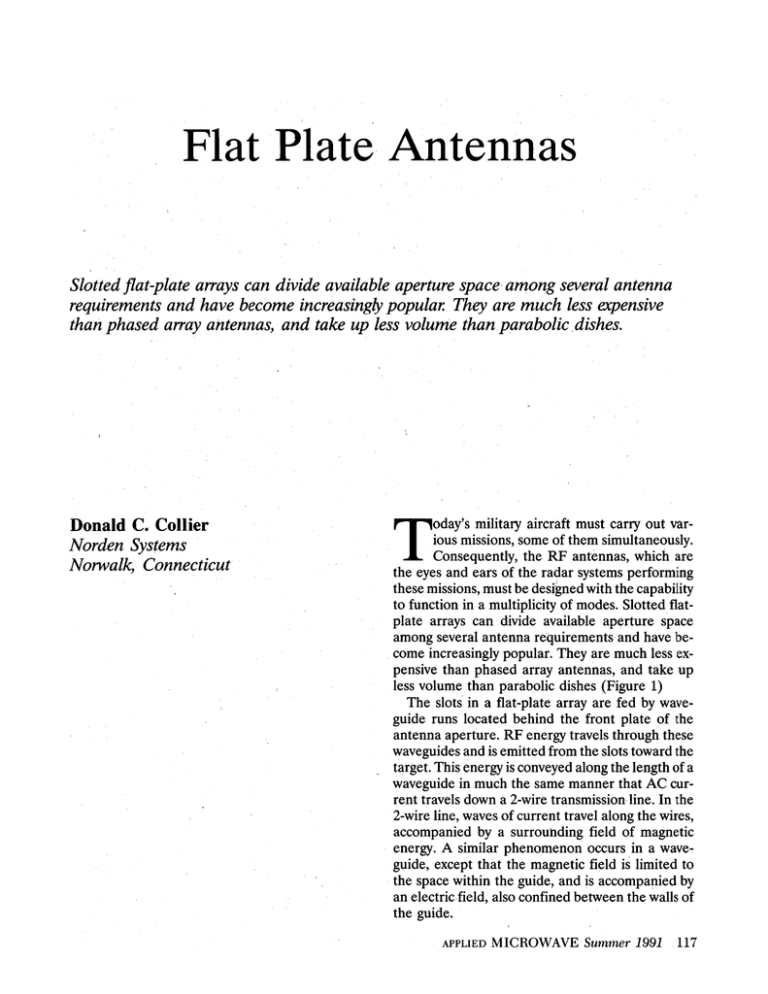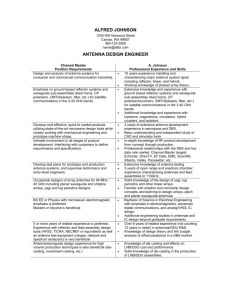Flat Plane Antennas
advertisement

Flat Plate Antennas Slotted flat-plate arrays can divide available aperture space among several antenna requirements and have become increasingly popular: They are much less expensive than phased array antennas, and take up less volume than parabolic dishes. T Donald C. Collier Norden Systems Norwalk, Connecticut . oday's military aircraft must carry out various missions, some of them simultaneously. Consequently, the RF antennas, which are the eyes and ears of the radar systems performing these missions, must be designed with the capability to function in a multiplicity of modes. Slotted flatplate arrays can divide available aperture space among several antenna requirements and have become increasingly popular. They are much less expensive than phased array antennas, and take up less volume than parabolic dishes (Figure 1) The slots in a flat-plate array are fed by waveguide runs located behind the front plate of the antenna aperture. RF energy travels through these waveguides and is emitted from the slots toward the target. This energy is conveyed along the length of a waveguide in much the same manner that AC current travels down a 2-wire transmission line. In the 2-wire line, waves of current travel along the wires, accompanied by a surrouhding field of magnetic energy. A similar phenomenon occurs in a waveguide, except that the magnetic field is limited to the space within the guide, and is accompanied by an electric field, also confined between the walls of the guide. APPLIED MICROWAVE Summer 1991 117 Figure 1. Flat-plate antennas for airborne applications (photo courtesy of Rantec Corp.) This shorted, rectangular waveguide can be conIn waveguide, this electromagnetic wave doesn't move straight along the axis like water down a pipe, verted into a useful antenna array if the energy but propagates in zig-zag fashion, reflecting off the contained within the guide is allowed to escape into side walls. For this reason, a wavelength of RF as free space in a controlled manner. It was discovered seen looking dawn q piece of waveguide (called during World War I1 that if the current sheets were guide wavelength) is longer than the free space wa- interrupted by a slot approximately one-half wavelength long, an electric field could be set up within velength of the same RF energy. The effect of shorting out one end of either type the slot that would radiate into the space surroundof transmission line is, however, identical. At the ing the waveguide. In fact, it was found to have a short circuit a current maximum and a voltage mini- far-field pattern similar to that af the half-wave mum occurs, the travelling wave reflects back on dipole. The shunt radiating slot technique is illusitself, and a standing wave is created. This shorted trated in Figure 3. arrangement is useful for slot array antenna design. One difference between the two cases is seen in the behavior of the current. Instead of being confined to the two wires, waveguide RF current travRF SHEET WAVEGUIDE TOP SHORT CURRENT OR BROAD WALL ClRCUn els in "sheets" down the inside surface of the waveguide walls. Because one end of the guide is shorted, regularly spaced current nulls are observed at half-wave (guide wavelength) intervals. Depending on the phase of the current, these nulls are called either "sources," if charge is dispersing, or "sinks," if charge is accumulating. ~ h e ~ " m i ~ h t I WAVEGUIDE SIDE OR NARROW WALL I look something like the illustratibn in Figure 2, if 2 I I sheet current could be instantaneously photoFigure 2. Sheet current flow pattern in a waveguide. graphed in its dominant mode. \ 118 APPLIED MICROWAVE Summer 1991 \ / INTERRUPTED TRANSVERSE SHEETCURRENT WAVEGUIDE SLOTS Figure 3. Shunt radiating slots cut into the broad wall of waveguide. Narrow slots are cut into the broad wall of the waveguide at the same location as the sinks and sources, but offset laterally from them, so they interrupt the flow of the RF sheet current. The position of the slots forces the current to travel around the air gaps in the guide face. Since these slots or gaps have little height but are one half wavelength in length, the RF phase of the sheet current at the bottom of the slot as drawn is roughly 180 degrees out of phase with the current at the top of the slot, since the current must travel an extra 180 degrees to arrive at the bottom. As is the case across any impedance, this sets up a potential difference between top and bottom of the slot, and an electric field is created in the air gap. As the phase of the RF current fluctuates, likewise the electric field builds up and collapses sinusoidally at the RF rate, and thereby radiates into the surrounding space. The amount of radiation can be varied by controlling the amount of sheet current to be intercepted. It was found that the type of slot illustrated interrupts minimal current when it is cut near the waveguide centerline, and maximum current near the waveguide edge wall. In this way, the desired slot radiation voltage can be precisely regulated. To achieve a useful far-field pattern, the electromagnetic energy emitted from each slot must combine additively (in phase) in the desired propagation direction. As can be seen in Figure 3, the direction of the sheet current changes every half guide wavelength. To compensate for this alternating out of phase radiation, the adjacent slots are located on alternate sides of the waveguide's broad wall centerline, thus assuring additive electric field radiation phase in free space. It will be observed from the earlier illustrations that sheet current in a waveguide travels basically in two directions: longitudinally down the length of 120 APPLIED MICRO.WAVE Summer 1991 the guide and transversely from top face to bottom face of the guide. This is analogous to current in a two-wire transmission line having series and shunt resistances. The slots just described are called "shunt" slots, because they interrupt the flow of transverse current in the same way that R(shunt) behaves in the two-wire line analogue in Figure 4. - I I Figure 4. Two- wire transmission line equivalent circuit of the waveguide slot radiator. The slots shown in Figure 5 are called "series" slots because they interrupt the flow of current travelling along the guide, as does R(series) in Figure 4. INTERRUPTED LONGITUDINAL SHEETCURRENl ELEiTR.: FIELD w- %--A SERIES WAVEGUIDE SLOTS Figure 5. Series slots cut into the broad wall of the waveguide. The radiation voltage of a series slot is controlled by varying the degree of rotation from the waveguide centerline. If there is no rotation, it will radiate no RF energy, since it lies along the guide centerline and cuts minimal sheet current. It follows that a slot rotated until it is perpendicular to the guide centerline radiates maximum energy. In a series slot, the current reversal previously described in any shorted waveguide is compensated for by reversing the sense of rotation of the slot, as shown in Figure 5. Series slots are useful in antenna design, because ANTENNA PATTERN they couple RF energy not only to free space, but also to adjacent waveguides. If two mutually perpendicular waveguides were connected through their broad walls by a series slot, RF could be made to pass between the two. In this manner one guide can act as a "feed guide" to a row of. vertically oriented waveguide runs or "sticks," as illustrated in Figure 6. SCAN ANGLE (DEG) Figure 7a. Azimuth pattern in the pencil beam mode. SERIES SLOTS ANTENNAPATTERN 3 I Figure 6. Typical flat-plate array showing shunt and series slots, as well as vertical stick radiating guide sections driven by a feed guide with series slots. The flat-plate antenna shown is an array of waveguide sticks grouped into 8 subarrays, 2 per quadrant. The individual radiators are shunt slots, horizontally polarized (i.e., the electric field is horizontal). Each subarray or module is fed by one length of horizontal waveguide located behind the array front face. RF energy is coupled between the vertical waveguide sticks and the horizontal feed guide via angled series slots. Three antenna modes are required for basic military aircraft applications; 1) a pencil beam for long range target location; 2) a cosecant-squared (CSC2) or shaped beam mode for mapping and ground target identification; and 3) an elevation monopulse mode for Terrain Following/Terrain Avoidance (TF/TA). In the pencil beam mode, all eight subarrays radiate, resulting in the far-field patterns of Figure 7. In the shaped beam mode, an RF switch allows only the slots in the upper half of the array to radiate. The introduction of a fixed phase shift into the central row of the active aperture half changes the pencil beam in the elevation plane to a cosecantsquared beam. P. Smith of Norden Systems invented this novel means of achieving the shaped beam, and the method has been widely adopted by flatplate designers. Patterns for this mode are illustrated in Figure 8. 122 APPLIED MICROWAVE Summer 1991 SCAN ANGLE (DEG) Figure 7b. Elevation pattern in the pencil beam mode. The final mode, elevation monopulse for TF/TA operation, becomes possible with the inclusion of a magic tee at the RF input/output port, as shown schematically in Figure 9. The difference pattern is ANTENNA PATTERN 0 a. 10 E aa 40 SO 60 -90 -70 -50 -30 -10 10 30 SCAN ANGLE (DEG) 50 70 90 Figure 8a. Azimuth pattern in the shaped beam mode. ANTENNA.PRTTERN 0 10 Virtually all of the more modern fighter-bomber, attack, and interceptor aircraft have slotted flatplates as their primary RF sensors. Until the electronically-scanned phased array becomes economically viable, the flat-plate antenna represents the best way to perform the multiple functions required of today's military airplanes. - 60 I -90 I -70 I I I -50 I -30 I -10 I I I 10 I 30 I I 50 I 70 ~ I ~ 90 SCAN ANGLE (DEG) Figure 8b. Cosecant-squared pattern in elevation plane. taken from the difference port of the magic tee, the pencil beam pattern from the sum port. Figure 10 shows the resultant sum and difference pattern superimposed. E Bibliography ' 1. Microwave Transmission Design Data, pp. 111-120, Theodore Moreno, Dover Pub.,J1948. 2. Microwave Antenna Theory and Design, pp. 286-295, Samuel Silver, Peter Peregrinus Ltd., 1949. 3. Antenna Analysis, pp. 169-178, Edward A. Wolff, John Wiley and Sons, Inc., 1967 4. Resonant Slots with Independent Control of Amplitude and Phase, Bernard J. Maxim, IRE Transactions on Antennas and Propagation, July 1960. 5. The Impedance Properties of Narrow Radiating Slots in the Broad Face of Rectangular Waveguide, Arthur A. Oliner, IRE Transactions on Antennas and Propagation, January, 1957. 6. Slotted Waveguide Antenna Arrays, Hung Yuet Yee and Philip N. Richardson, IEEE Antennas and Propagation Society Newsletter, December 1982. 7. Antenna Theory, Part I, R.E. Collin and F.J. Kucker, McGraw-Hill, 1969: 8. Multimode Array Antenna, P.W. Smith, U.S. Patent No. 4,376,281. ROW OF ELEMENTS WITH FIXED PHASE SHIFT Figure 9. Simplified schematic of beam shape switching tethnique showing RF switch in the cosecant-squared mode position. ELEVATION (DEG) Figlire 10. Superpositionof the elevation sum and difference patterns. Donald C. Collier received the M A degreefrom Middlebury College, Madrid, Spain in 1960 and the BA degree from Middlebury College, Middlebug Ikrmont in 1959. He received the BSEE and MSEE degrees in 1966 and 1974 from the University of Florida, Gainesville. He has been engaged in array antenna ,design since 1972. The antenna built for his master's thesis later was granted a patent, as have several other of his designs. He haspublished extensively in English and Spanish, having become fluent in technical Spanish while founding the Electronics Department at the InstituteXaloc in Barcelona, Spain from 1969 to 1972. He has a wide range of antenna experience, having worked on broadband ECM antennas at General Electric, flatplate, slottedwaveguide antennas at Taas Instruments and at Norden, and wideband, monopulse phased array antennas at General Dynhmics. MECollier has long been interested in computer-aideddesign of antennas, as well as computerprediction of antenna far-field patterns, and has developed an atensive library ofprogram, including spiral, slot, horn, parabolic dish, phased array, conical and adaptive array simulations for Hewlett-Packard computers. He has been with Norden System as a Senior Antenna Design Engineer since 1986. APPLIED MICROWAVE Summer 1991 123



